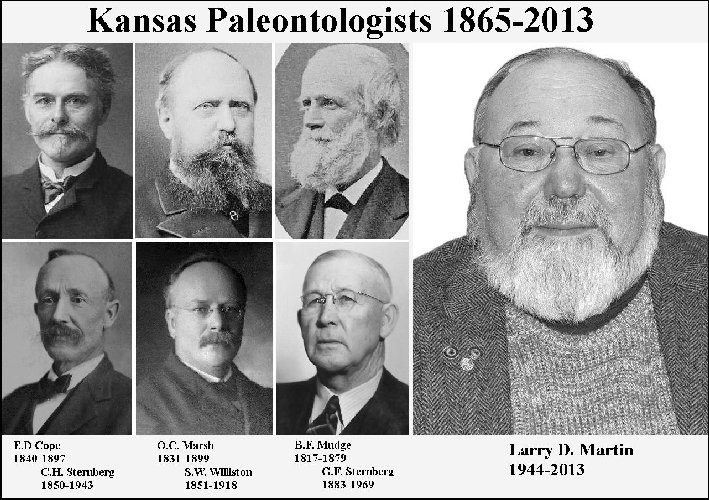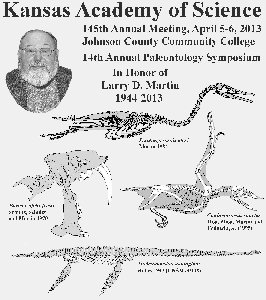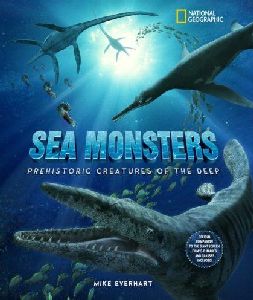|
Connolly, A.M. and Martin, L.D.
Biodiversity Institute, 2. University of Kansas. THE PALEOBIOGEOGRAPHICAL
EFFECTS OF THE PARIETAL FORAMEN ON MOSASAURS.
Modern vertebrates living in high
latitude environments require a larger pineal gland or parietal foramen
(PF) than vertebrates living in low latitude environments. This
correlation, however, may or may not apply to ancient vertebrates because
the PF is rarely researched. Mosasaurs (Squamata, Mosasauridae) are a
group of extinct marine lizards that were distributed worldwide during the
Late Cretaceous. The global distribution of mosasaurs makes them ideal for
testing the biogeographical effects of the PF. In order to test the
biogeographical effects of the PF, a ratio was calculated between the
length and width of the PF
to the length of the parietal bone. The ratios were then averaged between
specimens belonging to the same genus. This averaged ratio was then
compared to the latitudinal distributions of their respective genera. A
second test was done by comparing the PF size of specimens of varying
latitudinal distribution within the same genus using the same calculated
ratio. High latitudinal mosasaurs, such as Platecarpus
and Plioplatecarpus, had a larger PF than low latitude
mosasaurs Clidastes and Tylosaurus. These results
likely indicate that the PF controlled the latitudinal distribution of
mosasaurs among genera as it does in extant squamates. The second test was
focused on high‐ vs. low‐latitude‐dwelling
specimens of
Platecarpus and Plioplatecarpus. Specimens studied all had
about the same PF size. This pattern likely indicates that Platecarpus and
Plioplatecarpus individuals were not restricted to any latitudinal
zone. More specimens need to be analyzed before a confident evaluation can
be made for both tests.
Everhart, M., Sternberg Museum of
Natural History. A NEW SPECIMEN OF THE MARINE TURTLE,
PROTOSTEGA GIGAS COPE (CRYPTODIRA;
PROTOSTEGIDAE), FROM THE LATE CRETACEOUS SMOKY HILL CHALK OF WESTERN
KANSAS.
The remains of the first Protostega
gigas turtle (YPM 1408) were
discovered in the upper Smoky Hill Chalk
(Late Cretaceous; early Campanian) of western Kansas by the Yale
Scientific Expedition of 1871. Later that same year, E.D. Cope collected
and named the type specimen (AMNH FR1503), then described it in 1872.
Since that time, more than a dozen reasonably complete specimens have been
discovered in the Smoky Hill Chalk member of the Niobrara Formation, most
of them by Charles H. or George F. Sternberg. P. gigas was the
largest known marine turtle in the
Western Interior Seaway during early Campanian time, and was only eclipsed
in size by the later occurring Archelon ischyros. In October 2011,
a new, articulated specimen of P. gigas (FHSM VP‐17979)
was collected from the middle Santonian chalk above Hattin’s marker unit
7 in eastern Gove County, Kansas. Most of the skull is missing and the
left humerus is severed at mid‐shaft.
In addition, the turtle exhibits nearly a hundred puncture wounds on the
plastron, damage which is consistent with a failed predatory attack by a
large mosasaur like Tylosaurus proriger. Although the remains
appear to be those of an adult, the specimen is relatively small in size
(80 cm across the carapace) compared to later occurring examples of the
species. The specimen also represents the earliest documented occurrence
of this species, extending the fossil record of P. gigas some 2
million years.
Falk, A.R., University of Kansas.
CREATING A SYNTHESIS BETWEEN AVIAN ICHNOLOGY AND ORNITHOLOGY
Avian ichnology and ornithology
(including paleo‐ornithology)
have been considered
two disparate field of study. Most ichnologists are primarily geologists,
whereas ornithologists are biologists; this has created a false dichotomy
between the two fields that has rarely been bridged. A few
recent studies, mostly examining fossil trackways from the ?Jurassic and
Miocene of Argentina, have begun building a framework between modern and
ancient bird tracks; however, there is still a great deal of work to be
done. No studies have quantified avian trace making behaviors, resulting
in a shortage of studies on modern avian tracks. As a result, few attempts
have been made to identify potential avian trace makers. Tracks, in
general, are identified as shore birdlike or webbed footed, and no further
identifications are made. Too often, track evidence is not included in
studies of avian paleodiversity and paleobiogeography, which results in an
incomplete dataset; for example, there are no avian body fossils in South
Korea, however, there are several Early Cretaceous avian tracksites with
thousands of individual tracks. Focusing solely on body fossils and
disregarding trace fossils can result in major errors when reconstructing
the distribution of fossil birds. Trace fossils also represent hidden
diversity: there are tracks from the Lower Cretaceous Haman Formation of
South Korea that are identical to those left by modern spoonbills;
however, no body fossils of spoonbill ecomorphs are known. Examining both
body and trace fossils will give researchers a better understanding of
avian origins and their early
evolution, diversification and distribution.
Gibson, S.Z., University of Kansas
Department of Geology and Biodiversity Institute. SEMIONOTID
FISHES (NEOPTERYGII: SEMIONOTIFORMES) FROM
THE UPPER TRIASSIC CHINLE FORMATION: NEW SPECIES
AND COMMENTS ON THE RELATIONSHIPS OF SEMIONOTIFORM FISHES.
Fossilized remains of
semionotiform fishes from the Upper Triassic
Chinle Formation of the southwestern United States are abundant,
yet understudied. In this investigation, I describe a new genus from
specimens collected from Triassic (Norian) deposits in Lisbon Valley,
Utah, with two new species, as well as specimens previously attributed to Semionotus
kanabensis. One of the new species within the new genus displays a
unique
combination of characteristics, including a unique cranial suspensorium
with a short, ventrally expanded vertical preoperculum; expanded
infraorbitals that contact the preoperculum; deep body with pronounced
postcranial hump; and dense tuberculation that begins on the skull roof
and continues onto the dorsal ridge scales and dorsolateral flank scales.
The other new species is smaller and lacks the deep body morphology and
postcranial hump and tuberculation. It also differs in the morphology of
the suspensorium, but shares the expanded infraorbitals that contact the
anterior ramus of the preoperculum. Expanded infraobitals are also
described in Semionotus kanabensis, and while they are also found
in other ginglymodian taxa, they are not observed in other species of Semionotus
and are unique to this group of fishes in the United States. A
phylogenetic analysis shows that this new genus of semionotid fishes is
distinct from and sister to the genus Semionotus within the family
Semionotidae.
Hageman, S.A., Claycomb, G.D., and
Hoffman, B.L., Park University. CLASSIFICATION AND CHEMICAL ANALYSIS
OF THE PARK UNIVERSITY BALTIC AMBER COLLECTION (EOCENE).
Currently, the majority of the Park
University amber collection is composed of 30 specimens with 32 insects
and described as Baltic amber (Eocene). An analysis reveals 38%
Hymenoptera, 31% Unknown (6 winged; 1 wingless; 3
unidentifiable), 22% Diptera and 9% Other.
Unfortunately, identifications are complicated by surface
cracking that obscure details. The Order
Hymenoptera is represented by Chalcidoidea wasps, Mymaridae
wasps, Formicidae ants and other unidentified Parasitic wasps. The Order
Diptera is represented by Nematocera (Mycteophiloidea; fungus gnats),
Trichoptera (caddisfly), and Cyclorrphapha (advanced flies). Also present
is one specimen each of Neuroptera (lacewings), Coleoptera (beetles) and
Acari (ticks and mites). The rarest individual in the collection appears
to be a larval tick that has six legs and a distinctive spot on the back
(resembling a modern Amblyomma),
but
the gnathosoma is not visible for
confirming it is a tick or a mite. Instrumental analysis is important in
determining the chemical composition of amber, such as succinic acid
levels, which aids in determining
the age and botanical origin of the amber.
These 30 samples provide an opportunity to confirm they are
Baltic samples and not of other European origins (Bitterfeld, Rovno or
Scandinavian) by comparing chemical results to known resin properties.
Early indications suggest a Baltic origin, but chemical signatures will
hopefully translate to a known forest or tree species of a specific Eocene
stage.
Hamm, S.A., Wichita, KS. THE FIRST
ASSOCIATED TOOTH SET OF PTYCHODUS MAMMILLARIS IN NORTH
AMERICA.
Described here is the first
occurrence of an associated tooth set of the Ptychodontiform
shark P. mammillaris (FHSM VP 17989)
from the Pfeifer Shale member (Lower middle Turonian) of the Greenhorn
Limestone in Russell County, Kansas. The specimen consists of 47 teeth and
represents the earliest stratigraphic occurrence of the species in Kansas
and the Western Interior Seaway. Although found disarticulated, this tooth
set consists of teeth from eight different tooth file positions which
demonstrates the heterodonty in the dentition of P. mammillaris.
This specimen is unique as the lower medial teeth from this tooth set are
the largest teeth of P. mammillaris found in North America to date.
Hoffman, B.L. and Hageman, S.A.,
Park University. AMPHIBIAN REMAINS FROM THE IOLA AND WYANDOTTE LIMESTONES,
KANSAS CITY GROUP (UPPER PENNSYLVANIAN) IN PLATTE COUNTY,
MISSOURI.
We have recently recovered
scattered amphibian remains from acetic acid macerations of the Argentine
and Frisbie Limestone members of the Wyandotte Limestone Formation and the
Raytown Limestone member of the Iola Limestone Formation. Although the
remains are fragmentary and not identifiable to the species level, they
are consistent with the Microsauria. Few skull fragments have been found:
a relatively complete dentary bone, six stapes and fragments that are
consistent with the small toothed palatine and vomer bones of several
microsaurs. Most of the remains consist of about 220 vertebrae, including
the atlas‐axis complex, as
well as several presacral and postsacral vertebrae. One femur is the only
element of the appendicular skeleton that has been identified. These
amphibians likely inhabited a freshwater environment near an estuary,
being consumed by fishes swimming upriver that transported the remains to
the marine environments in which these limestones were deposited, as
evidenced by abundant sea urchin, conodont, shark, crinoid, sponge,
brachiopod and mollusk fossils. This site is located along a band
extending through Texas, Colorado, Oklahoma, Kansas, Illinois, Ohio, Nova
Scotia, Ireland, Germany and Czech Republic, which would have been
positioned at about 5‐10
degrees north paleolatitude during the Upper Pennsylvanian. This appears
to be the first report of amphibian remains in these strata.
McCartney, S., Pittsburg State
University, Palm Beach Museum of Natural History, Wichita Paleontological
Society. THE MODERNIZATION OF FIELD COLLECTING METHODS IN PALEONTOLOGY: A
CASE STUDY.
The process of fossil collecting
with regard to field work has always been a challenging
task. The field collector or collecting
party has spent most of the history of paleontology working with
some specific issues: extreme conditions of
collecting sites, exact locations of current or past sites, site and
depositional information recording, and field identification. The
collecting party has for most of the past had to operate as an independent
extension of the institution or entity it was doing the collecting for.
This has become improved with the use of cell phones and the features of
smart phones and the Internet. With recent advancements in the field of
computers, software and scanning technology, the techniques used for
fossil collecting and data capture can be greatly refined and produce
higher qualities of the data recorded. In this presentation a case study
is provided to illustrate how implementation of the use of mobile
computers, the Internet, scanners and consumer‐friendly
software can be used in conjunction to bring modern data collection
techniques to the field of paleontology.
McCartney, S., Ward, J.R.,
Pittsburg State University, Palm Beach Museum of Natural History,
Wichita Paleontological Society. A NEW PROCESS FOR THE CREATION,
MANIPULATION AND RESTORATION OF 3D VIRTUAL MODELS FOR RAPID PROTOTYPING OF
FOSSIL SPECIMENS.
Three dimensional (3D) modeling has
always been an integral part of the paleontological process of research. Originally
this was accomplished through the use of skilled artists creating hand
drawn and sculpted
replicas of fossil remains. Now with the
advent of more advanced computers, elaborate but user friendly
software, and relatively inexpensive portable 3D scanners, it is possible
to create a virtual model of the fossil specimens. Utilizing a Next Engine
scanner, an accurate 3D model is created and complied with the assistance
of the scanner software. This digital file or “digital specimen” can
now be modified and manipulated as needed to either capture a specific
aspect or for the purpose of restoration. Through the use of commercial
available software such as Autodesk 3D Max or Z Brush, the effects of
deformation and damage to the original specimen can be removed from the
digital specimen. Once this
process has been completed, the digital
specimen can then be sent to any form of rapid prototyping machine or
output process.
|



